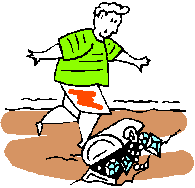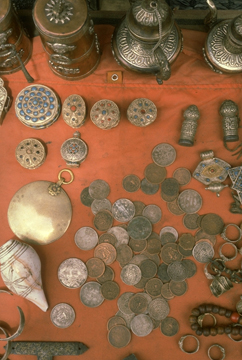Lesson Two,
"Looking Up" Treasure, A
Vocabulary Treasure Hunt
Activity I: Anticipatory Activity, "Found a Peanut"
Activity II: Looking up “Treasure”, digital reference desk
Instructional Objectives
-
Students learn to use greater
detail when describing objects for documentation purposes.
-
Third Grade Writing Standards:
Writing descriptions that use concrete sensory details to present and
support unified impressions of people, places, things or experiences.
-
Systematic vocabulary
development for sorting, categorizing, and classifying their
treasures.
-
Use sentence and word context
clues to find unknown word meanings.
-
Use a dictionary to learn the
meaning and other features of unknown words.
-
Students will collect natural items
(i.e. rocks, seeds, feathers, shells, cones) and manmade items (i.e. coins,
sea glass, chunks of conglomerate rock, plastic.)
Time
Required
-
"Found a Peanut" - One
class period
-
Vocabulary Treasure Hunt
worksheet- One
to two class periods
-
The active collecting quest is an ongoing one week activity.
Advance
Preparation
Materials
/ Resources Required
- "Found a Peanut": one or two large bags of peanuts still in the
shell, (large enough bag for each student to have two with a few left over,)
colored markers, flat cookie sheet type tray, chart paper, brown lunch sacks
(one for every 5 students,) chart paper, lined student paper, Collector's
Field Log
- Internet Access
- Vocabulary Treasure Hunt: hot list containing student centered digital reference desk
resources.
- Vocabulary Treasure Hunt worksheet copies
one for each student
- Students' Collection Boxes and Collector's Field Logs
- Vocabulary chart posted in the classroom
related to collecting, sorting and describing objects. Suggested
chart would contain word, rebus and definition.
Unit Vocabulary,
By
Lesson
| Lesson 1 |
Lessons
2 and 3 |
Lesson 4 |
| artifact |
journal (n. v.) |
attributes |
manmade |
antique |
museum |
| collect |
label (n. v.) |
categorize |
material |
curator |
precious |
| collection |
log |
category |
metal |
display |
precious metal |
| decorate |
natural |
characteristics |
organize |
floor plan |
precious stone |
| discover |
nature |
classify |
reference desk |
map (v, n) |
|
| document (n. v) |
object |
criteria |
sort |
|
|
| features |
record (n. v.) |
define |
texture |
|
|
| gather |
rock |
discriminate (sort by criteria) |
unique |
|
|
| illustrate |
treasure |
fossil |
valuable |
|
|
| item |
|
heirloom |
|
|
|
|
|
junk |
|
|
|
Concepts
- Developing and asking meaningful
questions
- Collecting data
- Analyzing to identify
relationships and logical conclusions
- Distinguishing relevant from
irrelevant information
- Sequencing and prioritizing
information
- Observing patterns
- Describing detailed features of once living and non living objects.
Procedures
Activity I, Anticipatory Activity, "Found a
Peanut"
- Open a new bag of peanuts in front of the class and remove two whole
shells.
- Select two whole peanut shells that appear to be alike in both size and
shape.
- Display the peanuts for the class and ask the students to brainstorm
methods for identifying these two peanut shells from all the others if they
were returned to the bag.
- Record ideas on chart paper. (2-3 minutes)
- Using a red and green marker, place a large dot on both ends of each
shell. One shell should have two red dots and the other shell should
have two green dots.
- Replace the peanuts in the bag, shake/mix them up and then pour them out
on a cookie sheet and select two students to come up and find the two
peanuts. (for fun time the students seeing how long it takes them)
Cooperative Groups, "Found a Peanut," continued
- Move into cooperative learning groups of 5 or more and assign tasks:
- materials person, (gets one bag and fills it with two times as many
peanuts than students in the group)
- time keeper, (makes sure group is on task and can note start and stop time
for step 6 to monitor how more difficult the peanut hunt becomes.)
- reporter, (reports to class the procedures used by their
group for marking their peanuts)
- shaker, (makes sure all marked peanuts are placed in the bag and shakes
bag to mix them up)
- cheerleader, (makes positive comments to group members complimenting them
on their cooperative behavior and give only positive comments encouraging
students who follow their assigned tasks.)
- Repeat the steps in the anticipatory activity using the brown
paper bags containing twice as many peanuts as students in the group.
- Each student will get one peanut the others in the bag are to make the
task of identifying the peanuts more difficult.
- In cooperative groups asking each student to select a method for
marking their peanut with a colored marker, this time tell them they need to
make a very small, "secret," mark that may fool others in their
group and requires each member to examine their peanut more closely.
- Ask each reporter to give a brief retell of what criteria individuals used
for identifying their peanuts.
- Using the remaining unmarked peanuts students are to reach in the sack and
select one of the new peanuts.
- Give them 3-5 minutes to closely observe and examine their new peanut.
- Students are not to use any manmade means of identification for this new
peanut.
- Have them look at their peanut very closely to find characteristics they
believe they can use to identify their peanut from all others in the bag.
- They must examine the characteristics and unique form of their peanut in
its natural state.
- After the class feels they have had enough time to fully examine and
locate at least three definable characteristics for their peanut...
- Return all the peanuts to the bag. The marked and unmarked peanuts.
There should be twice as many peanuts as students.
- Ask students to find both their marked and unmarked peanuts as quickly as
they can by using the characteristics they observed during the three-five
minute observation period.
- Ask each group's recorder to record all the describing words, (adjectives)
and characteristics they used to sort from the others. (5 minutes)
- Return to the chart giving each group a turn to name one characteristic
used until all the adjectives have been listed.
- Lead a discussion of how students refined their characteristics and added
greater detail as the sorting group got larger.
- Ask students to record words they might find themselves using to
describe their collection. Record the words on the inside, front and
back, covers of their Collector's Field Log.
- Extension: put two groups together to mix and locate their peanuts
- Extension: put the entire class together in one sack and see how difficult
it is to discriminate their peanut from all others.
Activity II,
Looking up “Treasure”, digital reference desk
- Begin creating a vocabulary chart with a rebus where applicable
for the following terms: gather, collect, collection,
discover, manmade, natural, and nature.
- "Vocabulary Treasure Hunt," Use Reference Desk Hot List to access
digital reference tools.
- Students record definitions on their Vocabulary Treasure Hunt
worksheet
as they use the on-line
digital reference resources.
Extensions
or Follow-up
Students will
maintain their Collector's Field Log
adding greater detail describing specific attributes of their collected items.
Homework
- Complete vocabulary worksheets
- Ongoing
Assign homework: complete student field logs when adding items found at home to
their boxes.
Illustrative Materials, Vocabulary Treasure Hunt
worksheet,
digital reference tools, Collector's Field Log,
Teacher's vocabulary preparation
sheet
Evaluation
Treasure
Hunt Worksheet Evaluation*:
| Complete Worksheet, 95-100% accurate. |
Exceeds Expectations |
19-20 Points |
A+ |
| Complete Worksheet, 85-94% accurate.
Complete Worksheet, 75-84% accurate. |
Meets Expectations |
17-18 Points
16-15 Points |
A
B |
| Complete Worksheet, 65-74% accurate. |
Minimal Effort |
13-14 Points |
C |
| Incomplete Worksheet, 55-64%accurate. |
Needs Improvement |
12 Points or less |
D |
*(Points are suggested, may be modified as necessary)
Home









